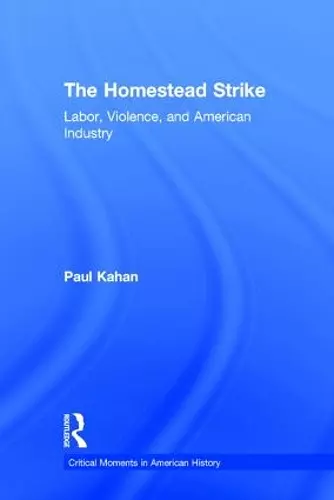The Homestead Strike
Labor, Violence, and American Industry
Format:Hardback
Publisher:Taylor & Francis Ltd
Published:13th Dec '13
Currently unavailable, and unfortunately no date known when it will be back
This hardback is available in another edition too:
- Paperback£38.99(9780415531948)

On July 6, 1892, three hundred armed Pinkerton agents arrived in Homestead, Pennsylvania to retake the Carnegie Steelworks from the company's striking workers. As the agents tried to leave their boats, shots rang out and a violent skirmish began. The confrontation at Homestead was a turning point in the history of American unionism, beginning a rapid process of decline for America’s steel unions that lasted until the Great Depression.
Examining the strike’s origins, events, and legacy, The Homestead Strike illuminates the tense relationship between labor, capital, and government in the pivotal moment between Reconstruction and the Progressive Era. In a concise narrative, bolstered by statements from steelworkers, court testimony, and excerpts from Carnegie's writings, Paul Kahanintroduces students to one of the most dramatic and influential episodes in the history of American labor.
1. Anthony DeStefanis, Otterbein
I like that the book promises a narrative on Homestead that connects it to larger issues in the history of the nineteenth century and will also include some primary sources. There are lots of primary source readers that take this approach (the Bedford history and culture series, for instance), but it seems that you are going to spend more time and space on the narrative before you get to the primary sources.
I think making the connections between Homestead and what was happening more broadly in the economy, business, and the lives of working-class people will be particularly useful in the classroom.
If done right, I think this book could have a very long shelf life and could be very successful. Homestead is an event that many professors touch on in the courses I listed in #1 above. These courses are taught at many colleges and universities, and thus you will have a large built-in audience. You will have a good chance to make this book a mainstay in these courses if it is accessible, readable, and compelling.
2. David Anderson, Louisiana Tech
I do believe a market exists at the university level for this book if it fits my needs, i.e., it uses a single event to advance broad claims about a particular era or historical development, in this case, the Gilded Age class conflict and the historical development of new technologies, new forms of business organization, and new political ideologies.
I would also agree with the author that a market for this book potentially exists at the numerous historical sites and museums that have some connection to the Homestead Strike, although must confess to having no knowledge about the yearly attendance at those sites.
What I find most appealing about this proposal is the author’s stated goal of providing college-level history professors with a "concise narrative of the Homestead Strike (with accompanying primary documents)" and one that would serve as a important supplemental text for a variety of U.S. History courses.
3. Paul Krause, University of British Columbia
Approaching the lockout as a problem in collective and public memory is a way to link it to the present – and to ask all sorts of questions about the corporate order, as it emerged and triumphed in the Gilded Age, and as it has been reconstituted in our own. One question would of course take up labor and unions.
The events that occurred in Homestead, Pa. in 1892 shaped labor relations and impacted the experience of the next two generations who worked on the factory floors and walked the picket lines. This readable history provides the context for understanding the strike and gives voice to the individuals whose decisions determined its outcome.
– Anne P. Madarasz, Museum Division Director, Heinz History Center, Pittsburgh
The Homestead lockout and strike forever changed the landscape of American labor relations. While it is often the violence of the day that brings people to the story, the real narrative is one that was years, if not decades in the making. It is this vitally important "back story," the lead up to the battle and its aftermath, as well as the lessons of the day that are so well presented by Dr. Kahan. He allows the reader to wrap their arms around the facts and to grasp the true context of the events that, to this day, still have a lasting impact on our culture.
– Ron Baraff, Director of Museums and Archives, Rivers of Steel National Heritage Area
"...this is a welcome, classroom-ready survey, entertaining and accessible to students. Summing Up: Recommended."
--G.A. Lancaster in Choice
ISBN: 9780415531931
Dimensions: unknown
Weight: 385g
174 pages